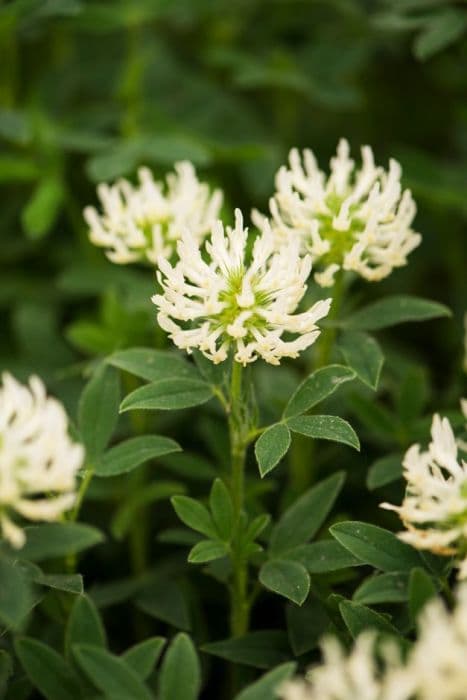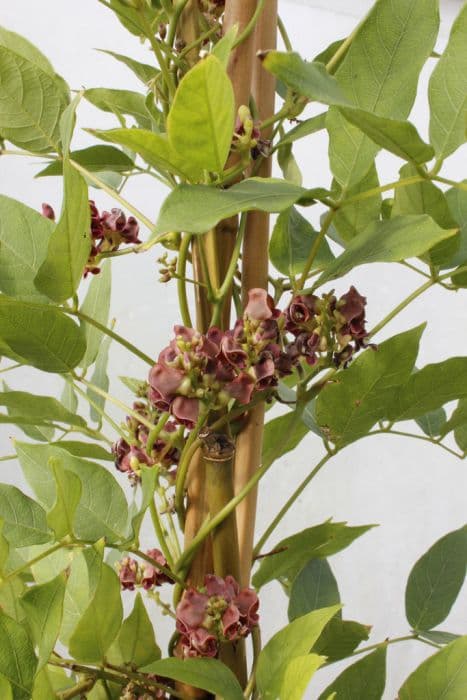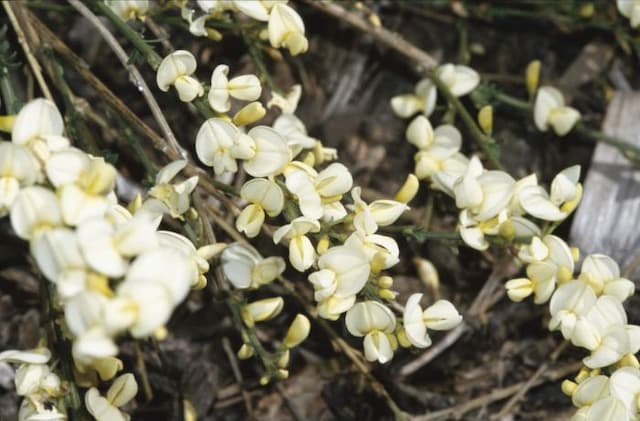Sulphur Clover Trifolium ochroleucon

ABOUT
Trifolium ochroleucon, commonly known as Sulphur Clover, is a perennial plant characterized by its distinctive clover-like foliage and flowers. The leaves are usually arranged in groups of three, which is a typical clover leaf configuration. The foliage tends to be a rich green, offering a fresh visual appeal throughout its growing season. The flowers of Sulphur Clover are the highlights of the plant. They present themselves in rounded clusters, resembling tiny pompoms atop slender stems that rise from the foliage below. These flower clusters are usually a soft, pale yellow—giving the plant its common name, 'Sulphur' Clover, due to their sulphur-like coloration. The subtle yellow blooms can add a warm touch to the setting in which the plant grows. With its charming flowers and typical clover leaves, Sulphur Clover exhibits a classic clover silhouette that can be easily recognized. Despite the avoidance of sizing metrics, it's key to note that it is proportionate to what one might expect from a clover species, fitting well amongst other plants in a mixed setting such as a meadow or a garden border where it can contribute to biodiversity and aesthetic diversity.
About this plant
 Names
NamesFamily
Fabaceae
Synonyms
Sulphur Clover, Hare's-foot Clover, Pale Clover
Common names
Trifolium ochroleucum, Trifolium alpestre, Trifolium ochroleucon subsp. alpestre, Trifolium ochroleucon subsp. ochroleucon.
 Toxicity
ToxicityTo humans
The plant Trifolium ochroleucon, commonly known as sulphur clover, is not widely recognized for being toxic to humans. There is little to no documentation of toxicity or poisoning symptoms related to the ingestion of this plant by humans. As with any plant not typically used for consumption, it is still advisable to exercise caution and avoid ingesting it without clear evidence of its safety.
To pets
The plant Trifolium ochroleucon, commonly known as sulphur clover, is not known for being poisonous to pets. There is limited information on its toxicity to animals such as dogs and cats, and it does not appear on common lists of plants that are toxic to pets. However, as with any non-food plant, pet owners should monitor their animals to prevent ingestion and consult a veterinarian if any unusual symptoms or behaviors occur after potential exposure.
 Characteristics
CharacteristicsLife cycle
Perennials
Foliage type
Deciduous
Color of leaves
Green
Flower color
Yellow
Height
1-2 feet (30-60 cm)
Spread
1-2 feet (30-60 cm)
Plant type
Herb
Hardiness zones
4
Native area
Europe
Benefits
 General Benefits
General Benefits- Nitrogen Fixation: Trifolium ochroleucon, commonly known as large hop trefoil, is a legume that can fix atmospheric nitrogen, enriching soil fertility and reducing the need for synthetic fertilizers.
- Forage Quality: As a forage crop, large hop trefoil provides high-quality feed for livestock with good protein content and digestibility.
- Biodiversity: It can enhance biodiversity by providing a habitat and food source for a variety of wildlife, including pollinators such as bees and butterflies.
- Soil Improvement: The deep rooting system of large hop trefoil helps improve soil structure and reduces erosion by stabilizing the soil.
- Weed Suppression: By establishing quickly and forming a dense cover, it can effectively suppress weeds, reducing the need for herbicides.
- Adaptability: Large hop trefoil can thrive in a range of soil types and conditions, making it a versatile plant for various ecosystems.
 Medical Properties
Medical PropertiesThis plant is not used for medical purposes.
 Air-purifying Qualities
Air-purifying QualitiesThis plant is not specifically known for air purifying qualities.
 Other Uses
Other Uses- Sulphur clover can be used in crop rotation to improve soil fertility by fixing nitrogen in the soil, thereby reducing the need for chemical fertilizers.
- As a forage crop, sulphur clover provides feed for livestock such as cattle, sheep, and goats, especially in organic farming systems.
- The flowers of sulphur clover can be dried and used in floral arrangements or potpourri mixtures due to their subtle color and shape.
- Bees and other pollinators are attracted to sulphur clover, making it an excellent choice for adding to a pollinator-friendly garden.
- Sulphur clover serves as a cover crop that can protect against soil erosion by establishing a quick-growing ground cover.
- The plant can be incorporated into wildflower meadows where it contributes to biodiversity and provides habitat for wildlife.
- In lawn mixtures, sulphur clover may be included as a low-maintenance and drought-resistant grass alternative.
- Its dense growth habit can outcompete weeds when used as a living mulch under fruit trees or in vegetable gardens.
- Sulphur clover is sometimes used in educational settings such as school gardens to demonstrate plant lifecycles and pollinator relationships.
- The seeds of sulphur clover can be collected for replanting or for use in cultivar development programs aimed at improving traits such as drought resistance or biomass production.
Interesting Facts
 Feng Shui
Feng ShuiThe plant Trifolium ochroleucon, commonly known as sulphur clover, is not used in Feng Shui practice.
 Zodiac Sign Compitability
Zodiac Sign CompitabilityThe sulphur clover is not used in astrology practice.
 Plant Symbolism
Plant Symbolism- Good luck: As a member of the clover family, Trifolium ochroleucon often shares the symbolism of luck traditionally associated with four-leaf clovers.
- Prosperity: Clovers, including Trifolium ochroleucon, can symbolize abundance and prosperity, as they often grow vigorously and in large numbers.
- Fertility: The lushness of clovers can also represent fertility and the idea of the Earth's capacity to nourish and sustain life.
- Protection: Some folk traditions hold that clover plants provide protection against evil spirits or bad luck, extending this belief to Trifolium ochroleucon as well.
 Water
WaterThe most common name for Trifolium ochroleucon is sulphur clover. To properly water sulphur clover, it's important to maintain a consistent moisture level without over-saturating the soil, as the plant prefers well-drained soils. Water sulphur clover deeply approximately once a week, providing about 1 to 2 inches of water each time. During periods of high heat or drought, you might need to water more frequently to prevent the soil from drying out. It's recommended to check the top inch of soil for dryness before watering again. Aim to provide a total of around half a gallon per square foot over the course of a month, adjusting based on rainfall and temperature conditions.
 Light
LightSulphur clover thrives best in full sunlight conditions. It should be placed in a location where it can receive at least 6 hours of direct sunlight daily. While it is adaptable and can tolerate partial shade, maximum flowering and growth are achieved with ample sunlight exposure. Ensure that the planting spot is away from prolonged shadows to keep your sulphur clover healthy.
 Temperature
TemperatureSulphur clover prefers temperate climates and typically flourishes in temperatures ranging from 60 to 75 degrees Fahrenheit. It can withstand temporary fluctuations beyond this range, with a minimum survivable temperature near the freezing point and it tends not to thrive in conditions consistently above 80 degrees Fahrenheit. The ideal temperature for growing sulphur clover is within this 60 to 75 degrees window to encourage optimal growth and blooming.
 Pruning
PruningSulphur clover benefits from occasional pruning to maintain its shape and promote denser growth. Prune in the late winter or early spring before the new growth begins. Trim back the dead or weak stems to encourage fresh, vigorous growth. If the plant is being grown for its ornamental value, more frequent trimming may be necessary to keep it looking tidy. The best time for pruning is after it has flowered, to avoid cutting off the flower heads if seed production is desired.
 Cleaning
CleaningNot needed
 Soil
SoilFor Pale Clover, a well-draining soil with organic matter is best. A mix of loam, peat, and sand with a pH of 6.0 to 7.5 will promote healthy growth.
 Repotting
RepottingPale Clover typically does not require frequent repotting due to its moderate growth; repotting every 2-3 years is sufficient.
 Humidity & Misting
Humidity & MistingPale Clover thrives at moderate humidity levels but is adaptable to variations, avoiding overly dry or damp conditions.
 Suitable locations
Suitable locationsIndoor
Place Pale Clover near a sunny window and rotate for even growth.
Outdoor
Ensure full sun to partial shade and protect Pale Clover from strong winds.
Hardiness zone
4-8 USDA
 Life cycle
Life cycleThe life cycle of Trifolium ochroleucon, commonly known as Sulphur Clover, begins with seed germination, where the plant emerges from its seed form when conditions are favorable, typically in spring. After germination, the seedling grows and develops a rosette of trifoliate leaves, characteristic of the clover genus. As it matures, Sulphur Clover enters the vegetative stage, establishing a deep root system and proliferating its leaf growth. Proceeding to the reproductive stage, the plant produces tall flower stalks with globular, pale yellow to cream flower heads that attract pollinators and subsequently produce seeds. Following pollination and seed set, the plant reaches senescence, where it starts to die back, especially after seed dispersal, but it can also regenerate from its rootstock if perennial. Throughout its life cycle, Sulphur Clover may also spread vegetatively through stolons, contributing to the survival and expansion of its population.
 Propogation
PropogationPropogation time
Spring-early summer
Propogation: The most popular method of propagating Trifolium ochroleucon, also known as Sulphur Clover, is through seed sowing. Seed sowing should ideally be done in the fall to allow for natural stratification during the cold winter months, which can enhance germination rates. The seeds are sown directly into the soil where they will grow. The sowing depth is generally shallow, at about 1/4 inch (about 6 mm), and seeds should be spaced adequately to prevent overcrowding. Adequate moisture is critical for germination, so the soil should be kept consistently moist but not waterlogged until germination occurs, which typically takes 14 to 21 days depending on environmental conditions. Once established, the plants are quite hardy and can propagate themselves by reseeding if the growing conditions are favorable.









